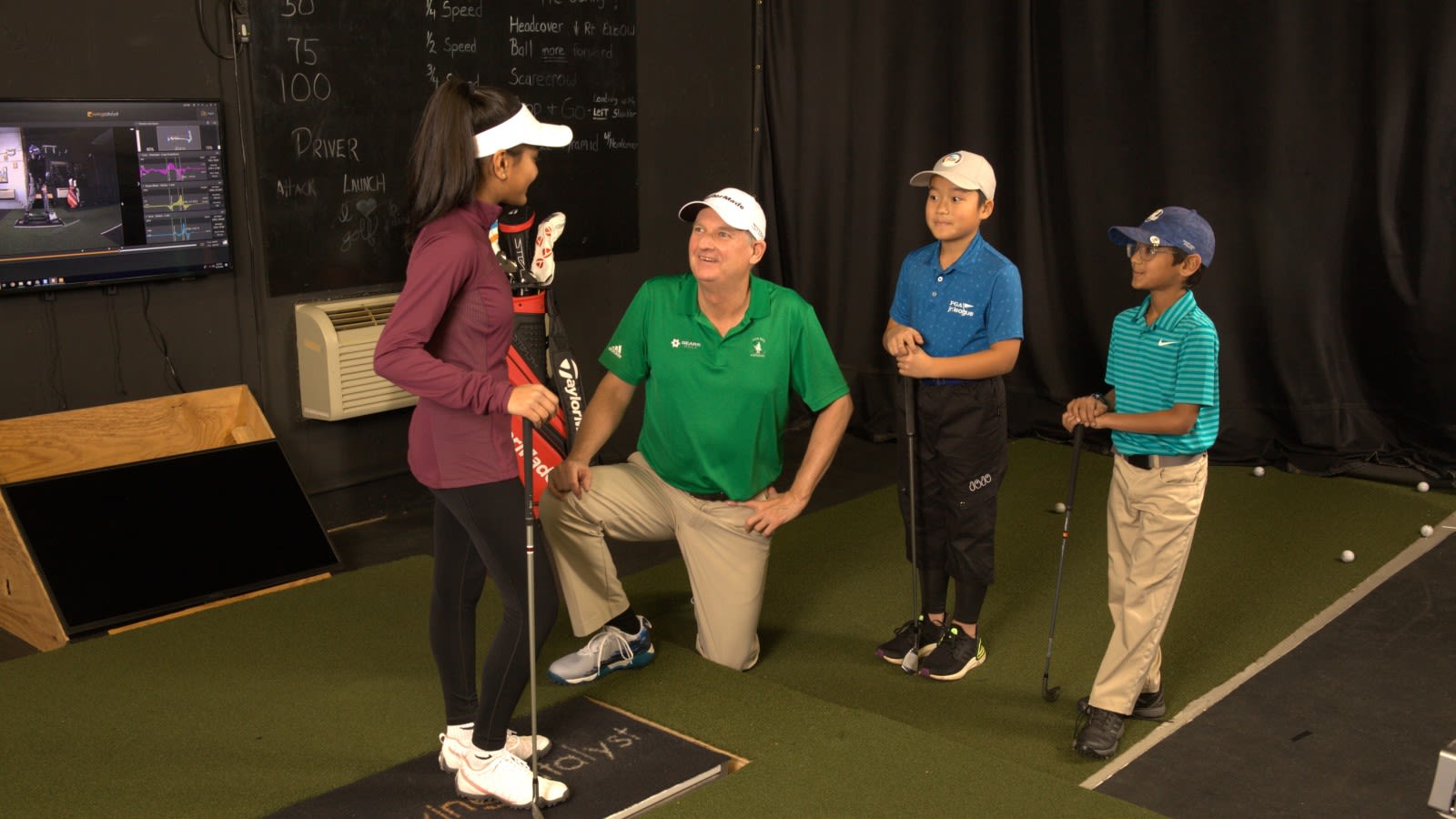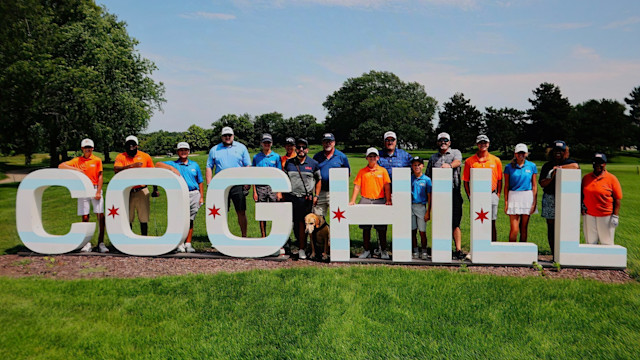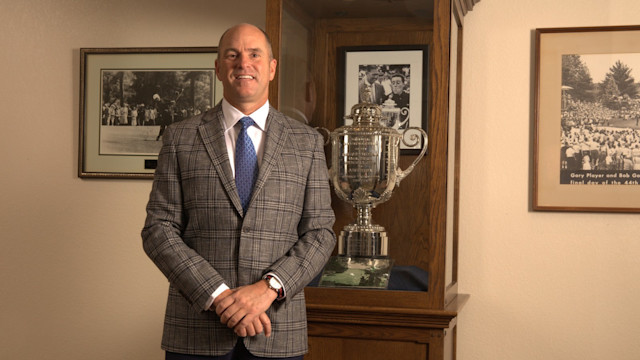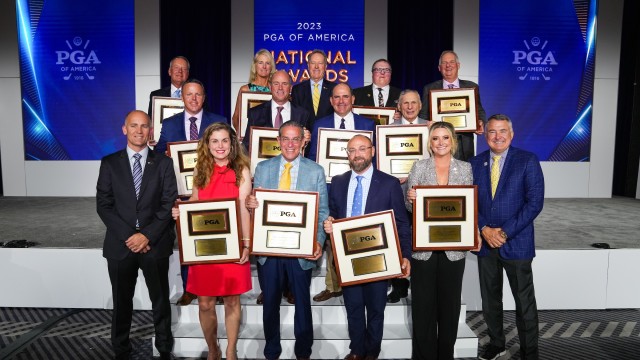Game Changers
From the PGA TOUR to PGA Jr. League, Kevin Weeks, PGA, Has Assembled An All-Star Coaching Career
By Roger Graves
Published on

(Photo by Russell Kirk/GOLFLINKS)
This story was originally published in the Feb. 2023 issue of PGA Magazine.
A lifelong relationship between coach and PGA TOUR veteran was hatched in October of 2008 at the Valero Texas Open. The story began when longtime PGA TOUR member Michael Bradley was struggling with his putting and asked putting guru Kevin Weeks to take a close look at his stroke in San Antonio. Weeks — the national 2023 PGA Teacher & Coach of the Year — worked extensively with Bradley that week in 2008 and the PGA TOUR regular was soon putting with precision and confidence.
“He (Bradley) asked what I could do with his ‘atrocious’ putting, and we started a relationship that week that has continued to this day,” reflects Weeks, the PGA Director of Instruction at Cog Hill Golf & Country Club in Lemont, Illinois.
“Michael was a great ball striker, but his putting was holding him back. He shot 66 the first day in San Antonio and was encouraged enough that we continued working over the winter and rebuilt his approach to putting,” recalls Weeks. “We basically changed his whole putting stroke. His setup wasn’t right, so we worked hard on getting him set up properly. We got his head in the proper position and got his right arm lower and softer.”
Bradley Wins in Puerto Rico
When Bradley calmly holed a nine-foot birdie putt on the 72nd hole to win the PGA TOUR’s Puerto Rico Open to begin the 2009 season for his first victory in nine years, much of the credit went to Weeks. Suddenly, not only was Michael Bradley a hot commodity on the PGA TOUR, but so was Weeks.
“Michael (Bradley) is as gifted, if not the most gifted athlete I ever worked with,” explains Weeks, a PGA Member since 1994. “It was nice to receive a little recognition when Michael started winning, but he did all the work.
“When I teach, I try not to take the athleticism away from a player. My job is to put players in position to let their athletic ability take over. I am always very careful to not over-teach anyone — especially tour professionals.”
Suddenly, Weeks’ stable of tour professionals were wearing out a path to the winner’s circle. Mark Wilson won the 2009 Mayakoba Classic, Bradley also won the 2011 Puerto Rico Open, Johnson Wagner won the 2011 Mayakoba Classic and 2012 Sony Open, George McNeill won the 2012 Puerto Rico Open, Kevin Streelman won the 2013 Valspar Championship and Dicky Pride won the 2015 Winco Foods event.
Plus, the PGA Tour Champions and Buy.com Tour professionals Weeks was working with accumulated many Top 10 and Top 25 finishes.
Then, just as his PGA TOUR students were trending toward long-term stardom, Weeks decided the vagabond life of an instructor on the PGA TOUR was not for him. He had a golden opportunity to serve as the PGA Director of Instruction at Cog Hill Golf & Country Club, a fine four-course facility in suburban Chicago (Lemont, Illinois) that provides programs for golfers of all ages, backgrounds and skill levels. He had proven his professionalism by coaching the finest players in the land, but now he chose to focus his expertise on teaching and developing the next generation of golfers.
“My time working with the best players in the world was very satisfying, but players wanted teachers out on tour with them more and more weeks,” explains the 58-year-old Weeks, who was born in Tuscaloosa, Alabama, and raised in Jackson, Mississippi. “It came down to the fact that I had to be on tour nearly every week or stay home. Also, I had a wife and two young daughters.
“While I enjoyed coaching and traveling on the PGA TOUR from 2000 to 2014, the knowledge I gained from the experience is what prepared me for the current chapter in my journey.”
Growing the Game at Cog Hill
The Jemsek family, which owns and operates the four courses and a year-round Learning Center at Cog Hill, wanted Weeks to organize and coordinate a series of instructional programs to grow the game. That included enhancing Cog Hill’s PGA Jr. League program, which the Jemseks knew had tremendous potential. Weeks also wanted a home base where he could establish a putting laboratory and conduct ground-breaking putting and short-game research.
“Carol Rhoades and I took over the PGA Jr. League program at Cog Hill, and it grew by leaps and bounds,” notes Weeks, a perennial Golf Digest Top 50 and GOLF Magazine Top 100 instructor nationally. “I loved all the different aspects of PGA Jr. League, from growing the game to developing elite juniors. I enjoyed not only developing their golf skills, but teaching the juniors leadership, sportsmanship and teamwork. All this made the decision to stay home an easy one.
“I was able to learn many valuable lessons about all aspects of the game of golf from the best players in the world and the best coaches, as well. And I am now using that knowledge to coach the next generation of junior golfers.”
When Weeks took over PGA Jr. League and other instructional programs at Cog Hill, there were only 14 youngsters. But in concert with Rhoades, a fall PGA Jr. League program was introduced to match the spring program. The youths practiced every Thursday after school with matches on Sunday, and participation quickly swelled to 48 players.
“The next year, I started a spring PGA Jr. League session comprised of five 90-minute practices designed to get the golfers ready for a busy summer of golf,” recalls Weeks. “Each week, we covered a different aspect of the game: driving, putting, pitching, chipping and iron play. Even though we were competing against baseball, 26 players signed up. That summer we had 48 PGA Jr. League players and enough teams to have our own in-house Cog Hill League.”
Today, PGA Jr. League Golf at Cog Hill is one of the largest programs in the country with more than 350 participants in the spring, summer and fall seasons. The Cog Hill All-Star teams compete for the national championship nearly every year and prepares high school golfers to take the next step in college.
“One of the reasons PGA Jr. League has been so successful at Cog Hill is the staff,” says Weeks, a three-time Illinois PGA Section Teacher & Coach of the Year. “Cog Hill supports us immensely, which allows us to keep our price low. Katherine Jemsek believes in this program and wants to give every kid in our area the chance to learn golf. We have great instructors — Clayton Pendergaft and Ryan McGwyer are essential as they both possess energy and passion for teaching juniors.
“When you truly care about your students, it shows. If you give parents a high quality product at a reasonable price, they will fill your programs.”
Enjoys Working With Youths
In 2014, the Cog Hill All-Star Team won the Southern Illinois Championship and advanced to the PGA Jr. League Regionals. By 2017, Weeks had enough players for nine teams and two leagues, which meant Cog Hill could field two All-Star Teams, giving even more players a chance to have postseason experience and extra practices.
“That’s a great treat for the juniors, and a chance for me to provide even more coaching,” notes Weeks. “While the purpose of PGA Jr. League isn’t purely to focus on competition, Cog Hill’s teams are proud to have qualified for the past six PGA Jr. League National Championships.”
The 2023 PGA Teacher & Coach of the Year acknowledges that teaching youngsters requires a much different approach than working with PGA TOUR players.
“When you’re working with young players, you’re building a golf swing and you have time on your side,” explains Weeks. “The big thing with young players is developing their skills and getting them to work on the process of getting better and not worrying about where the ball goes, or the results. Conversely, PGA TOUR players need results now.
“I don’t want the juniors comparing themselves to the other golfers their age. I discourage them from measuring their accomplishments by tournaments won. You can play great and finish 50th or play terrible and win; no one can control what the rest of the field does.”
The Process is Important
Weeks believes the key to working with tour players and youths is getting both to buy into the process and be patient with results. Trust the process and work on your plan, he says, and results will eventually follow.
“My favorite quote is from Joe Maddon, the former Cubs manager,” says Weeks, who often played golf with fellow Chicago sports legends Ernie Banks and Stan Mikita. “He says, ‘When you focus on results, you become fearful. But when your focus is on the process, it makes you fearless.’”
While Weeks has shifted from developing PGA TOUR champions to youth champions, he has also pioneered his own putting devices to benefit players of all skill levels. Showing a little “mad scientist” acumen, Weeks invented the Dynamic Impact Indicator, which uses a laser to accurately track how the putter’s face makes contact with the ball to provide directional data in real time. Along with other gadgets such as a putting robot, force plates and a 3D motion capture system, his Cog Hill studio features perhaps the greatest collection of state-of-the-art putting equipment anywhere.
“I started researching the putting stroke in the late 1990s because I did not believe straight back and straight through, which was the prominent coaching theory at the time, was effective for everyone,” says Weeks. “I had just enough physics in high school and college to question whether a club on an angle could swing straight back and straight through.
“I thought the golf swing had been fairly well researched, but I had so many putting questions that nobody could answer. So I started doing my own research.”
Weeks first paired a camera with his patented Dynamic Impact Indicator laser system. “That allowed me to measure the face angle at impact,” says Weeks. “I was able to co-design a
putting robot with the help of a mechanical engineer named Jim Shenoha that really proved to be a game changer. I could now make the putter swing however I wanted, and I could study what that did to the golf ball. I wanted my students to understand what’s important in putting. The work with the robot is what led me to understand that in putting, the ball starts purely on the face and path accounts for zero relative to the start line.”
Shapes His Teaching Philosophy
Weeks began developing his coaching philosophy as a player at Ole Miss under PGA Professional Ernest Ross, who coached the Rebels while serving as PGA Head Professional at The Country Club of Jackson in Jackson, Mississippi.
“When I was at Ole Miss, I was always trying to figure out what players were working on, why they were working on it and how it was going to help them,” recalls Weeks. “I was fascinated with how the golf swing worked. Then, when I graduated from college, I had an opportunity to follow my coach and first mentor, Ernest Ross, to The Country Club of Jackson. While working for him, I began to realize that I really wanted to teach.”
Weeks shaped his coaching philosophies by soaking up everything he could from Fred Griffin and Phil Rodgers at Grand Cypress in Florida, and from other instructors at the John Jacobs Golf Schools. Jumping back and forth from jobs as an assistant in Florida during the winters and Cog Hill Golf & Country Club in Illinois during the spring and summer, Weeks would watch Dr. Jim Suttie, PGA, give lessons for hours to a variety of students, learning how Suttie approached all phases of teaching.
“I loved the science behind the golf swing and Dr. Suttie had the same passion,” notes Weeks, who started the Illinois PGA Teaching & Coaching Summit in 2009. “We hit it off at once, and I would not be where I am today without him passing on his knowledge. One of my biggest takeaways from Dr. Suttie was to never stop learning.
“I haven’t yet.”


